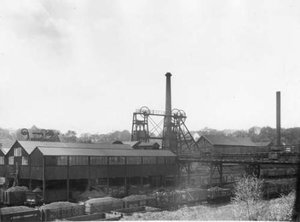Newcastle, England (Geography)
Newcastle, England
 Silverdale colliery, Newcastle (1830-1998). (Source: Applied and Environmental Geophysics Research Group, Keele University)
Silverdale colliery, Newcastle (1830-1998). (Source: Applied and Environmental Geophysics Research Group, Keele University) Newcastle, England ( 54°58'40.14"N, 1°36'47.60"W) has long been recognized for its early coal industry. Although coal had been mined in the region since ancient times, it was not until the 13th and 14th centuries that the industry truly gained speed. It was at this time that countryside border-wars destroyed Newcastle’s leather trade and gave way to the development of coal as the area’s dominant export.
Circa 1305, Newcastle began shipping coal to urban centers across England, including London. The expansion of the industry enabled the growth of the town itself and by 1334 Newcastle was the fourth wealthiest town in England. The coal trade also led to a surge in population growth and by 1372 Newcastle was home to 2,627 tax-paying citizens – the 11th largest populace in England.
Medieval coal mining was a dangerous and arduous trade. The common method of extraction involved digging shallow bell pits, named for the bell shape which resulted from digging down from the earth’s surface and then outwards into the coal seam, and miners were dropped into and lifted from the mine similar to a bucket in a well system. Collapses of mine roofs were rare and the greatest hazard to the workers came from the use of candles for lighting the mines creating the potential for coal gas explosions.
By 1378 Newcastle was exporting coal nation- and Europe-wide at the rate of 15,000 tons of coal per year. The trade would continue to flourish and by mid-17th century it is estimated that coal exports from Newcastle had risen to 400,000 tons per year with the town holding a virtual monopoly on the nation’s coal export. Newcastle’s success was due in part to its coastal location which allowed expedient transport by sea with hundreds of nationwide shipments per year. The phrase 'Carry coals to Newcastle' came to suggest an unnecessary or superfluous action, indicating the scope of the area's coal trade industry.
The success, however, would not last forever and by the 20th century coal exports had dramatically declined. Although 1956 marked the closing of the last remaining coal mine within Newcastle's borders, the impact of the coal trade upon the region is undeniable.
Further Reading
- Early Coal Mining, 1100 - 1500, The Northern Echo.
- Coal and Industry, 1500 - 1800, The Northern Echo.
- The Northern Coalfield, 1800 - 1900, The Northern Echo.